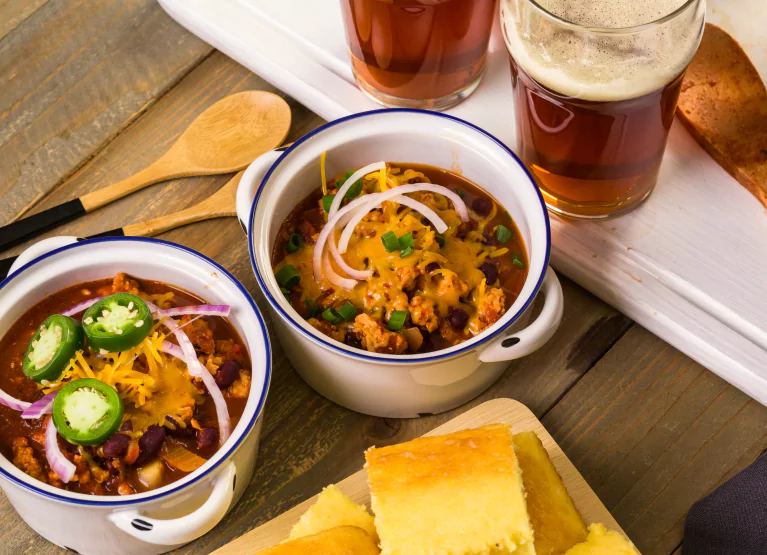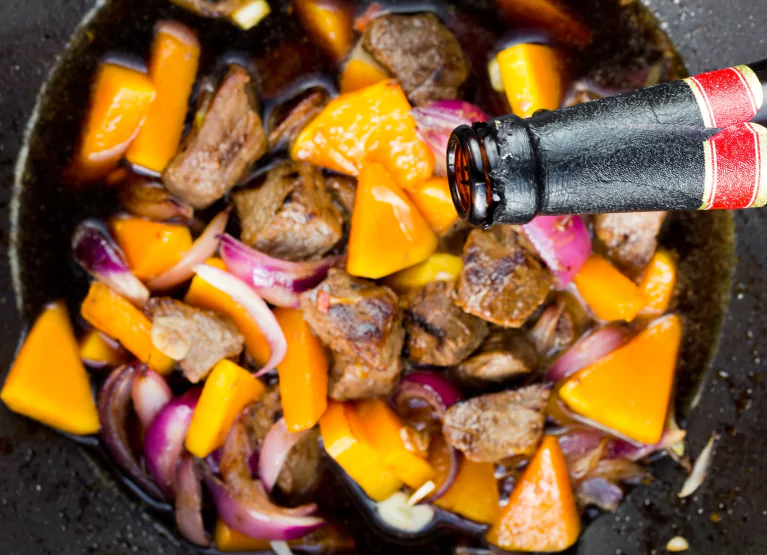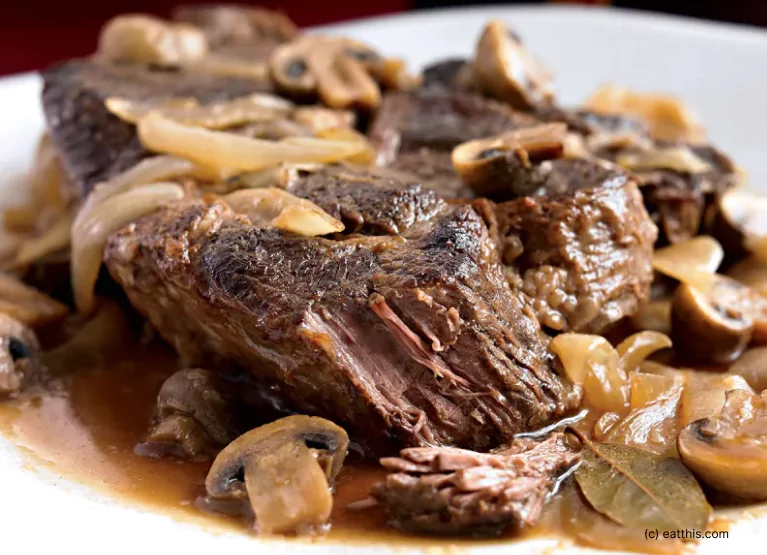Is Cooking with Beer Healthy? Your Oktoberfest Guide

Key Takeways
Are you a beer lover looking to expand your horizons? Lots of people may love to enjoy a nice, cold beer from time to time, but did you know this fermented, hoppy beverage isn’t just for drinking?
That’s right—it can play a role in cooking and baking as well. From crispy beer battered fish to a delicious beer-based slow cooker recipe, there are many ways to incorporate beer into your favorite recipe to give it a new twist.
So, if you’re interested in learning about the impact of beer on your health and some of the benefits and downsides of cooking with different types of beer, keep reading!
Is Beer Healthy?
For many people, enjoying a beer every once in a while can be perfectly acceptable. The Dietary Guidelines for Americans recommends that men limit their consumption to two alcoholic drinks per day, and one per day for women.
As with many things, moderation when it comes to alcohol is important. Excessive alcohol use is an underlying cause for more than 30 conditions and diseases, including infectious diseases, cancer, diabetes, neuropsychiatric diseases, cardiovascular disease, and liver and pancreas disease.
However, some studies show that moderate consumption of beer may protect against cardiovascular disease and neurodegenerative diseases like Alzheimer’s. It is important to note, however, that each of these studies stress that the protective effects are specific to low to moderate alcohol consumption.
Beer consumption can have different effects on each person, so it’s important to listen to your body. Researchers also urge caution in drinking alcohol if you have certain medical conditions or take medication. If you have medical conditions or take prescribed medications that may interact with alcohol, talk to your doctor about whether beer is safe for you.
How Many Calories are There in Beer?

The nutritional content of beer can depend on its alcohol content and size of the serving. A standard 12-ounce bottle of beer, such as a lager, typically has an ABV between four and five percent, and around 153 calories.
A beer with a higher ABV, or alcohol by volume, will have a higher calorie content. The ABV of a pale ale or an india pale ale (IPA), for example, can vary between about five and eight percent, and can have almost 200 calories. A 12-ounce bottle of can of light beer, on the other hand, typically has an ABV of about three percent, and about 100 calories.
Craft beers can have deeper flavor profiles and generally have even higher ABVs than other types of beer. If you’re interested in the nutritional information of a particular beer, you may be able to find more information on the brewery's website.
Why Doesn’t Beer Have Nutrition Labels?
Interestingly, you won’t usually find calories, carbs, or other nutritional information on a can of beer. This is because labeling regulation is altered by the Food and Drug Administration, the federal agency that requires nutrition labels on food and beverages sold in the U.S.
As of today, nutrition labels are optional for alcohol manufacturers. However, alcohol products do have some labeling requirements. For example, products that contain ingredients that may cause reactions or sensitivities, like sulfites and synthetic dyes, have to be labeled. Distilled spirits must have their alcohol percentage labeled, as do wines with an alcohol percentage of seven or higher.
Beer and Blood Glucose

Beer contains carbs, which can have an impact on your blood sugar. Beer has a high-glycemic index, or GI, meaning its sugars are more likely to enter your bloodstream quickly and may cause a spike in blood sugar. For example, a pilsner beer has a GI of about 89, and a lager has a GI of about 100.
The time of day in which you drink beer may also have an impact on your health. Studies have shown that even moderate amounts of alcohol at night can negatively affect your blood sugar the next morning.
Other research suggests that alcohol consumption may also have negative effects on the hormones that regulate your blood sugar. If you’re concerned about the effect of alcohol on your blood sugar, it may be a good idea to consult a medical professional.
There are also many low-carb light beer options available that may reduce the risk of blood sugar spikes. Pairing beer with nutrient-dense foods with protein or fiber may also help blunt potential blood glucose spikes.
Benefits of Cooking with Beer
Cooking with beer is about more than just enhancing flavor, though it does that too. There are other benefits that come along with it.
Beer Can Add a Deeper Flavor
You may be familiar with foods fried in a beer batter, such as beer-battered onion rings, fries, or fish. Beer is commonly used in a batter because its carbonation gives the batter more acidity. This limits how much gluten can form while mixing the batter, giving it a better texture and preventing the batter from becoming too tough.
Baking or broiling meat in beer for dishes such as pork chops, short ribs, or pulled pork can add a dark, rich color to the meat and give it a deeper flavor. Some people prefer to use beer as a brine or marinade for meat.
This is because the beer used in the brine is able to penetrate inside the fat of the meat and carry the flavors from the brine deeper into the meat. However, when brining meat with beer, you want to be sure that you have some water in the brining solution to ensure it cooks properly.
May Reduce Harmful Chemicals from Forming

A 2014 study indicated that marinating meat with beer can reduce formation of chemicals called polycyclic aromatic hydrocarbons, or PAHs. These chemicals can form when food is cooked at high temperatures over coal, wood, oil, or gas, and have been linked to blood and liver problems, and some types of cancer.
The study used pilsner beer, non-alcoholic pilsner beer, and black beer. Black beer was found to reduce PAHs by 53 percent, non-alcoholic pilsner by 25 percent, and pilsner beer by 13 percent.
Downsides of Cooking with Beer
Cooking with beer may not be for everyone. Aside from beer’s potential effect on blood sugar, cooking with beer may also add alcohol to your dish that doesn’t fully dissipate. You may have heard that most alcohol burns off when you cook with it, though this isn’t exactly true.
How much alcohol dissipates can depend on how long the alcohol is heated, but 100 percent of the alcohol will never be lost. If you have to avoid alcohol for any reason, such as pregnancy or an alcohol use disorder, you may want to avoid cooking with it.
Tips for Cooking with Beer
Before cooking with beer, familiarize yourself with these tips.
Cook with a Beer You Enjoy

If you don’t like the taste of the beer when you drink it, there’s a good chance you won’t enjoy the flavor in your food. For example, if you prefer drinking a light lager, you may want to first experiment with using this type of beer in your recipe as opposed to a darker, malty beer like Guinness.
Take Note of the Beer’s ABV
As mentioned above, a beer’s ABV percentage will have an effect on the amount of calories and carbs it contains. Plus, the higher the ABV is, the more bitter the beer will taste. If bitter is not what you’re going for, stick with a lower ABV beer.
Use the Color of the Beer as a Pairing Guide
If you are using beer to cook a dish that is darker in color, like beef stew, brownies, or brisket, try using a dark beer like a stout or porter. If you are cooking a lighter food, like fish, chicken, or beer-battered fries, a lighter beer like a pilsner or lager might be a better choice.
3 Beer Recipes to Try Out
If you’re ready to try cooking with beer, these three recipes can help you explore some of the different types of meals that can be prepared with beer.
1) Belgian-Inspired Beef and Beer by Eat This, Not That

This beef and beer slow cooker recipe calls for a darker beer which will be absorbed by the chuck roast to enrich its juicy and tender flavor. While this option may not suit vegans or vegetarians, it’s a great way to add a delicious twist to your slow cooker meal.
Ingredients
- 1 tablespoon olive oil
- 3 pounds chuck roast
- Salt and black pepper to taste
- 2 tablespoons red wine vinegar
- 5 yellow onions, sliced
- 1 can dark beer (such as Guinness)
- 2 cups low-sodium beef stock
- 1 tablespoon Worcestershire sauce
- 4 bay leaves
- 8 ounces button mushrooms
2) Spicy Vegan Sloppy Joes from The Food Network
Mushrooms form the base of these vegan sloppy joes, which are flavored with veggies, spices, and a light beer. Try adding a source of protein like tofu to this meal to balance out your body’s blood sugar response.
Mushrooms are a good source of protective antioxidants and beta-glucans, which are polysaccharides that have been shown to have anticarcinogenic effects and stimulate the immune system.
Ingredients
- 1 pound cremini mushrooms, halved
- 1 tablespoon extra-virgin olive oil
- 1 large sweet onion, diced
- 1¾ cups light beer
- Kosher salt
- ⅓ cup finely chopped walnuts
- 1 small green bell pepper, seeded and diced
- Freshly ground black pepper
- ½ teaspoon chipotle chile powder
- ¼ cup ketchup
- 3 tablespoons tomato paste
- 6 whole grain hamburger buns
- Optional: shredded red cabbage or lettuce, pickled jalapeño and scallions
3) Beer-Braised Lentils from BBC Good Food

This tasty lentil dish is full of nutritious vitamins and minerals and uses a wheat beer to enrich its flavor. Lentils are legumes that are contain potassium, magnesium, fiber, protein, iron, copper, B vitamins, zinc, and phosphorus.
Research shows that nutrient-rich legumes like lentils may be beneficial against conditions such as hypertension, cardiovascular disease, and some types of cancer.
Ingredients
- 2 tablespoons olive oil
- 4 shallots, halved and finely sliced
- 200 grams puy lentils
- 175 milliliters wheat beer
- 600 milliliters lamb or beef stock
- 2 tablespoons fresh thyme leaves
Find the right Nutrisense programto turn insight into progress.
Go Beyond Glucose Data with Nutrisense
Your glucose can significantly impact how your body feels and functions. That’s why stable levels are an important factor in supporting overall wellbeing. But viewing glucose isn't enough. Nutrisense, you’ll be able to learn how to use your body's data to make informed lifestyle choices that support healthy living.
One-to-one coaching
Sign up to access insurance-covered video calls to work with a glucose expert: a personal registered dietitian or certified nutritionist who will help tailor your lifestyle and diet to your goals.
Monitor and measure what matters
With the Nutrisense CGM Program, you can monitor your glucose with health tech like glucose biosensors and continuous glucose monitor (CGM)s, and analyze the trends over time with the Nutrisense App. This will help you make the most informed choices about the foods you consume and their impact on your health.
Find your best fit
Ready to take the first step? Start with our quiz to find the right Nutrisense program to help you take control.

Heather is a Registered and Licensed Dietitian Nutritionist (RDN, LDN), subject matter expert, and technical writer, with a master's degree in nutrition science from Bastyr University. She has a specialty in neuroendocrinology and has been working in the field of nutrition—including nutrition research, education, medical writing, and clinical integrative and functional nutrition—for over 15 years.




